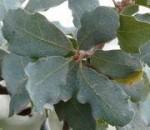 Also known as mountain oak and iron oak, California blue oak is found only in California where it grows on dry slopes of the interior hills surrounding the Central Valley. It is a long-lived deciduous tree and a member of the oak family, Fagaceae, that also includes beeches and chestnuts. The tree is often picturesque tree with its short spreading crocked branches and high rounded canopy. The light gray bark is checkered into scales and the simple, alternate leaves are bluish-green, one to three inches long, and irregularly lobed to entire. Usually have wavy margins and are somewhat rigid. Inconspicuous male and female flowers appear on the same tree in spring., the male flowers in drooping yellow-green catkins, the females often solitary in leaf axils of the current year. The female flowers give way in the fall to light green acorns darkening to brown with a shallow cup, ¼ to 1/3 as long as the nut. Blue oaks thrive in difficult sites with high heat and dry soil and do best when not pampered.
Also known as mountain oak and iron oak, California blue oak is found only in California where it grows on dry slopes of the interior hills surrounding the Central Valley. It is a long-lived deciduous tree and a member of the oak family, Fagaceae, that also includes beeches and chestnuts. The tree is often picturesque tree with its short spreading crocked branches and high rounded canopy. The light gray bark is checkered into scales and the simple, alternate leaves are bluish-green, one to three inches long, and irregularly lobed to entire. Usually have wavy margins and are somewhat rigid. Inconspicuous male and female flowers appear on the same tree in spring., the male flowers in drooping yellow-green catkins, the females often solitary in leaf axils of the current year. The female flowers give way in the fall to light green acorns darkening to brown with a shallow cup, ¼ to 1/3 as long as the nut. Blue oaks thrive in difficult sites with high heat and dry soil and do best when not pampered.
 Type: Deciduous tree
Type: Deciduous tree
Outstanding Feature: Habit, winter design, foliage
Form: Rounded canopy
Growth Rate: Slow
Bloom: Inconspicuous male and female flowers on the same tree in spring; the male flowers in drooping yellow-green catkins, the females often solitary in leaf axils of the current year
Size: 20-60’ h x 25-50’ W
Light: Full sun; tolerates light shade
Soil: Prefers dry, arid soil but tolerates a variety of poor soils.
Hardiness: Zones 8-11
Care: Low maintenance
Pests and Diseases: Dry rot, crown rot, root rot, brown rot, powdery mildew, caterpillars, insect calls, California oak moth, gall wasp, scale, mistletoe
Propagation: Seed